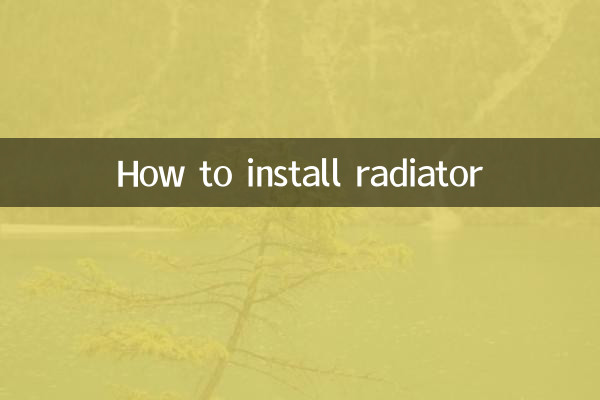How to install radiator
As winter approaches, the installation of radiators has become the focus of attention for many families. This article will introduce you to the installation steps, precautions and hot topics of the past 10 days in detail to help you easily cope with your winter heating needs.
1. Radiator installation steps

1.Measurement and Planning: First, you need to measure the room area and determine the number and location of radiators. Radiators are usually installed under windows or against walls to ensure even heat distribution.
2.Select radiator type: Choose the appropriate radiator type according to family needs. Common ones include steel radiators, copper-aluminum composite radiators, etc. The following is a comparison of popular radiator types in the past 10 days:
| type | advantage | shortcoming | Applicable scenarios |
|---|---|---|---|
| Steel radiator | Low price, fast heat dissipation | Easy to corrode | central heating |
| Copper-aluminum composite radiator | Corrosion resistant, long life | higher price | independent heating |
| Aluminum alloy radiator | Lightweight and beautiful | Weak ability to withstand pressure | small apartment |
3.Mounting bracket: Mark the installation position on the wall and use expansion bolts to fix the bracket to ensure that the bracket is level and firm.
4.Connecting pipes: Connect the radiator to the water supply pipe and return pipe, and use sealing tape to prevent water leakage. If it is an independent heating system, a temperature control valve also needs to be installed.
5.Exhaust and test: After the installation is completed, open the exhaust valve to remove air, check whether there is any water leakage, and ensure the normal operation of the system.
2. Installation precautions
1.Safety first: Be sure to turn off the water source and power supply during installation to avoid accidents.
2.Professional installation: If you are not familiar with the installation process, it is recommended to hire professionals to operate it to avoid poor radiator performance or safety hazards due to improper installation.
3.Regular maintenance: During the use of the radiator, the dust needs to be cleaned regularly and the pipelines should be checked for leaks to ensure long-term and efficient operation.
3. Popular topics in the past 10 days
The following are the hot topics on the Internet about radiator installation and winter heating in the past 10 days:
| topic | heat index | Main discussion points |
|---|---|---|
| Radiator vs floor heating | ★★★★★ | Which heating method is more energy efficient? |
| Intelligent temperature control system | ★★★★☆ | How to control your heating remotely from your phone |
| Radiator cleaning tips | ★★★☆☆ | DIY method for cleaning radiator |
| Radiator installation costs | ★★★☆☆ | Comparison of installation prices by region |
4. Frequently Asked Questions
1.How long does it take to install a radiator?: Usually takes 1-2 days, the specific time depends on the number of rooms and installation complexity.
2.Can the radiator be installed by myself?: If you have certain hands-on ability, you can try simple installation, but it is recommended to consult a professional.
3.What should I do if the radiator is not hot?: It may be air blockage or pipeline problem, try to exhaust or check whether the valve is open.
5. Summary
The installation of radiators is a technical job that requires careful planning and operation. Through the introduction of this article, I believe you will have a deeper understanding of the installation steps, precautions and current hot topics of radiators. If you have any questions, please leave a message in the comment area and we will be happy to answer you.

check the details

check the details